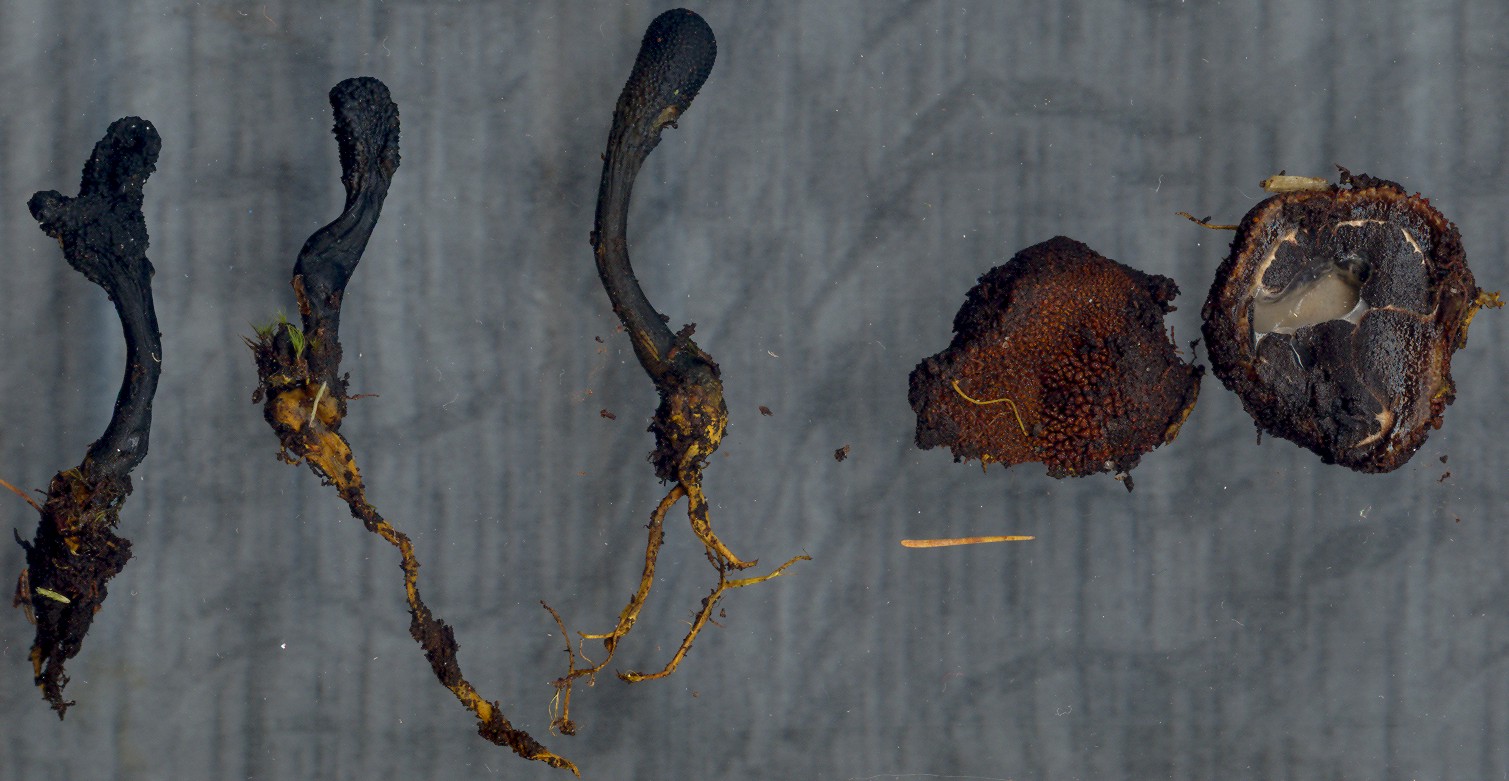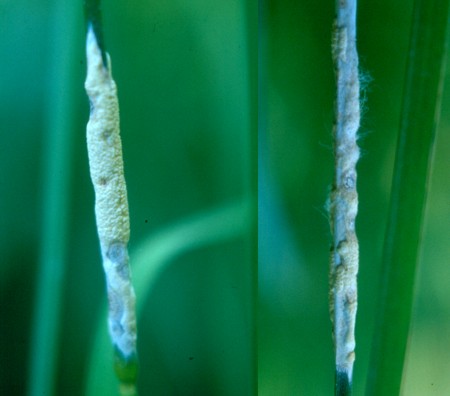Home >> Diversity and classification >> True fungi >> Dikarya >> Ascomycota >> Pyrenomycetes >> Sordariomycetes >> Hypocreomycetidae >> Clavicipitaceae
THE CLAVICIPITACAE, CORDYCIPITACEAE AND OPHIOCORDYCIPITACEAE
The Clavicipitaceae, Cordycipitaceae and Ophiocordycipitaceae form an interesting group of fungi thought until recently to be only distantly related to other Hypocreomycetidae. However, their light coloured ascospores and often colourful stromata are typical of many other members of this subclass. All of the Clavicipitaceae are either parasitic or live as endophytes on plants. They are characterized by their long filamentous ascospores and by asci with a dome-shaped apex and a distinct pore.

The genus Claviceps is famous (or infamous) because of the species C. purpurea, pictured above. Claviceps purpurea causes a disease of grasses called ergot. It is usually seen on grasses, as in the left panel, as elongated black sclerotia protruding from the florets where the grains should be. The panel second to left shows a whole pile of such sclerotia that were removed from a well-infected patch of wild grasses. The sclerotia contain a soft white tissue below the rind that might be very attractive to fungus-eating insects were it not for the fact that they contain some very toxic substances. There are insects that can tolerate the toxins and eat the sclerotia, but most probably cannot and will leave them alone. Humans are also susceptible to these toxins and can become seriously ill or even die from ingesting them. The symptoms, called ergotism, include muscle seizures, vomiting, diarrhea, and a burning sensation that led to the disease being called St. Anthony's Fire. Vascular (blood-vessel) constriction may lead to gangrene, especially in the extremities, including loss of the affected parts. Hallucinations and sometimes psychoses may also occur. Ergotism, associated with the consumption of infected cereal grains, especially rye, has been known for centuries but is now rare because the disease it causes in plants is better controlled.
Of course the sclerotia of C. purpurea have a role other than causing pain and discomfort to man and animals. In fact they play a very crucial part in the annual life cycle of the fungus by serving as a means of surviving the winter. When the sclerotia are mature they fall out of the inflorescence of the grass and lie on the ground where they will rmain for many months. At the time in the following season when the grasses are beginning to flower the sclerotia produce tiny stalked stromata bearing the perithecia. These can be seen on the ground and in the lab in the two right panels. They are not easy to find because they are so small, but if you mark a place where the sclerotia were abundant on the grass and return the next year when the grass is flowering you may be able to locate a few.

Species of Cordyceps, Ophiocordyceps and Tolypocladium produce stalked stromata similar to those found in Claviceps species except that they are usually much larger. Most species parasitize insects and other arthropods. In the picture above, the left panel shows O. variabilis, a parasite of the larvae of wood-boring beetles. The wood has been cut open to show the larva and the stroma arising from it. Ophicordyceps clavulata, in the middle panel, grows on scale insects and produces its stromata on the adult insect. The right panel shows Tolypocladium capitata an unusual species that parasitizes other fungi. The host fungus, a species of Elaphomyces, is at the base of the stalk of the stroma that is lying down. Elaphomyces species are members of the Eurotiomycetes that produce subterranean truffle-like fruiting bodies. If you think you may have found E. capitata or one of its relatives be sure to dig down and recover the Elaphomyces.



Tolypocladium ophioglossoides, subject of the three pictures above, is a common species in the coniferous forests of New Brunswick where it grows as a parasite on species of Elaphomyces. The dark ascomata closely resemble earthtongues and are often collected by people who later discover they should have dug down for the Elaphomyces. However, if you look closely at the fertile part of the ascomata you will see that in Tolypocladium ophioglossoides it is covered with small bumps marking the openings of the perithecia while in earthtongues the fertile part is quite smooth. To the right of the ascomata in the picture is an ascoma of Elaphomyces muricatus that had been connected to all three of the Tolypocladium ascomata. It has been cut in half so you are able to see both its granular surface and its fertile interior. The bright yellow rhizomorphs at the base of the Tolypocladium ascomata are the structures that form the link between the two participants. Below the picture of the ascomata are two long pictures showing an ascus with ascospores and then a single ascospore. Typical of all members of the order Clavicipitales the ascospores of Tolypocladium ophioglossoides are greatly elongated and septate. Once it has been discharged from the ascus the ascospores of this species are able to break up into unicellular "part-spores" that can function as single spores on their own.
Although they have been traditionally included in the Clavicipitaceae, modern studies indicate that the species parasitic on insects and fungi should probably be considered members of related families. Current classifications therefore place Cordyceps in the Cordycipitaceae and Ophiocordyceps and Tolypocladium in the Ophiocordycipitaceae.

Not all Clavicipitaceae produce stalked stromata. Epichloe typhina, pictured at right, is an endophyte (or possibly a parasite) of grasses that produces its stromata as a crust on the stem of its host. In the picture the stroma is the yellow crust dotted with the necks of the perithecia within. Dr. Thomas Bultman, a scientist at the University of Iowa, has studied the life history of E. typhina in detail and has discovered an interesting association between a small fly and this fungus. In the early part of the season E. typhina produces a crust of asexual spores on the surface of the grass. These attract the flies which arrive and "dance" around on the spore-bearing surface. They then fly to another and continue the dance. They also deposit their eggs there, which eventually hatch just as the thicker stroma with perithecia is developing. The small larvae of the fly consume a part of the stroma but always leave most of it to mature. Dr. Bultman has shown that during their visits the adult flies transfer the spores from one stroma to another and thus bring about cross-fertilization of the fungal colonies. This benefits the fungus but not the fly. Later the fungus rewards the fly with a small amount of its edible tissues. In this way the fly and the fungus have formed a mutualistic partnership that benefits both. In the picture both stromata show clear patches where they were eaten by the fly, yet the stroma at right is fuzzy at the top, indicating that it is producing abundant filamentous ascospores.